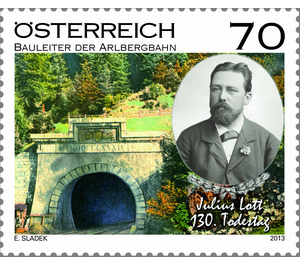130th anniversary of death - Austria / II. Republic of Austria 2013 - 70 Euro Cent
Theme: Traffic, Transportation & Mobility
| Country | Austria / II. Republic of Austria |
| Issue Date | 2013 |
| Face Value | 70.00 |
| Edition Issued | 812,000 |
| Printing Type | offset |
| Stamp Type | Commemorative |
| Item Type | Stamp |
| Chronological Issue Number | 2400 |
| Chronological Chapter | OOS-OE2 |
| SID | 496654 |
| In 59 Wishlists | |
The name Julius Lott is inextricably linked to the construction of the technically extremely demanding Arlbergbahn. This special stamp commemorates the 130th anniversary of the death of this important Austrian railway pioneer. The motif of the stamp shows next to the west portal of the Arlberg tunnel also a historical portrait of Julius Lott. Personal details: Born in Vienna in 1836, Lott completed his technical studies at the University of Karlsruhe in 1858, ie in the city where he also found his first employment in the construction of the Baden State Railways. In 1861, Julius Lott received the call of Carl von Etzel, the builder of the Brenner Railway. Etzel transferred him first individual project work and later the construction of the section Patsch -Matrei, the hardest part of the entire route. Lott completed this task with great bravery and created for the first time a name as a railway technician. His successful work on a wide variety of demanding railway construction projects gave Julius Lott a steep career in the following years. In 1875, he finally became k.k. Directorate of State Railway Construction. In May 1880, however, the work of Julius Lott reached its peak, when he was appointed Construction Director of the Arlberg Railway. Under his leadership, the finalization of the final project of the Arlbergbahn took place, followed by the construction of this project, which was carried out at government expense. Lott devoted all his creativity to implementing this project as quickly as possible - but ignoring his physical abilities, he finally became seriously ill and did not live to see the completion of this important project. Shortly before completion of the Arlbergbahn Julius Lott had to hand over the construction management to a certain Johann Poschacher, who successfully completed Lotts work. At the age of only 47, Julius Lott died on May 24, 1883 of miliary tuberculosis. For a long time mythical tales grew up around Lott's early death - for years the rumor persisted that Lott had chosen suicide because he feared that the tunnels from the east and west would not collide. Ultimately, however, this could be refuted correctly, as well as the suicide legend. In appreciation of his work, a monument was erected in St. Anton am Arlberg in the form of an obelisk, which was ceremonially unveiled on the occasion of the opening of the Arlberg Railway on 20 September 1884 by Emperor Franz Joseph I. Many years later, in 1913, Lottgasse was named after him in Vienna-Floridsdorf.


